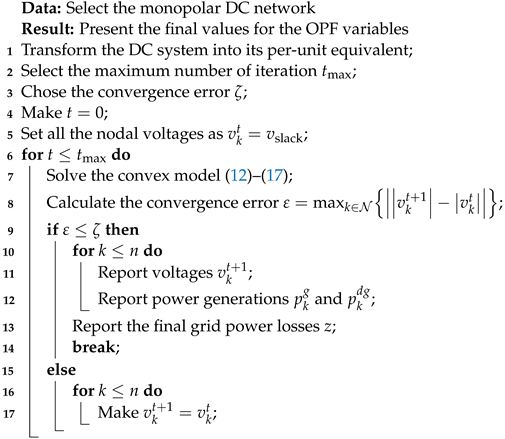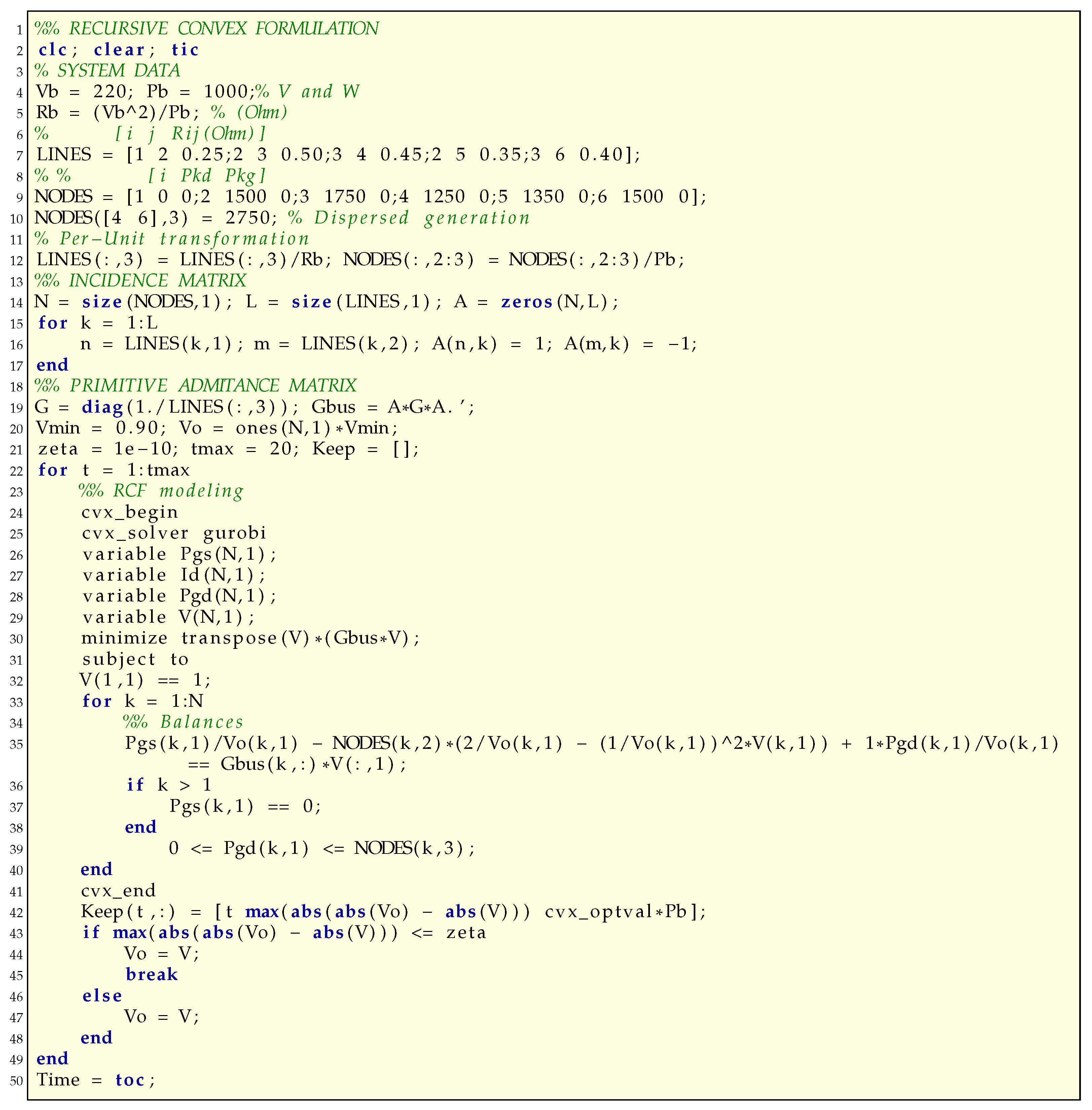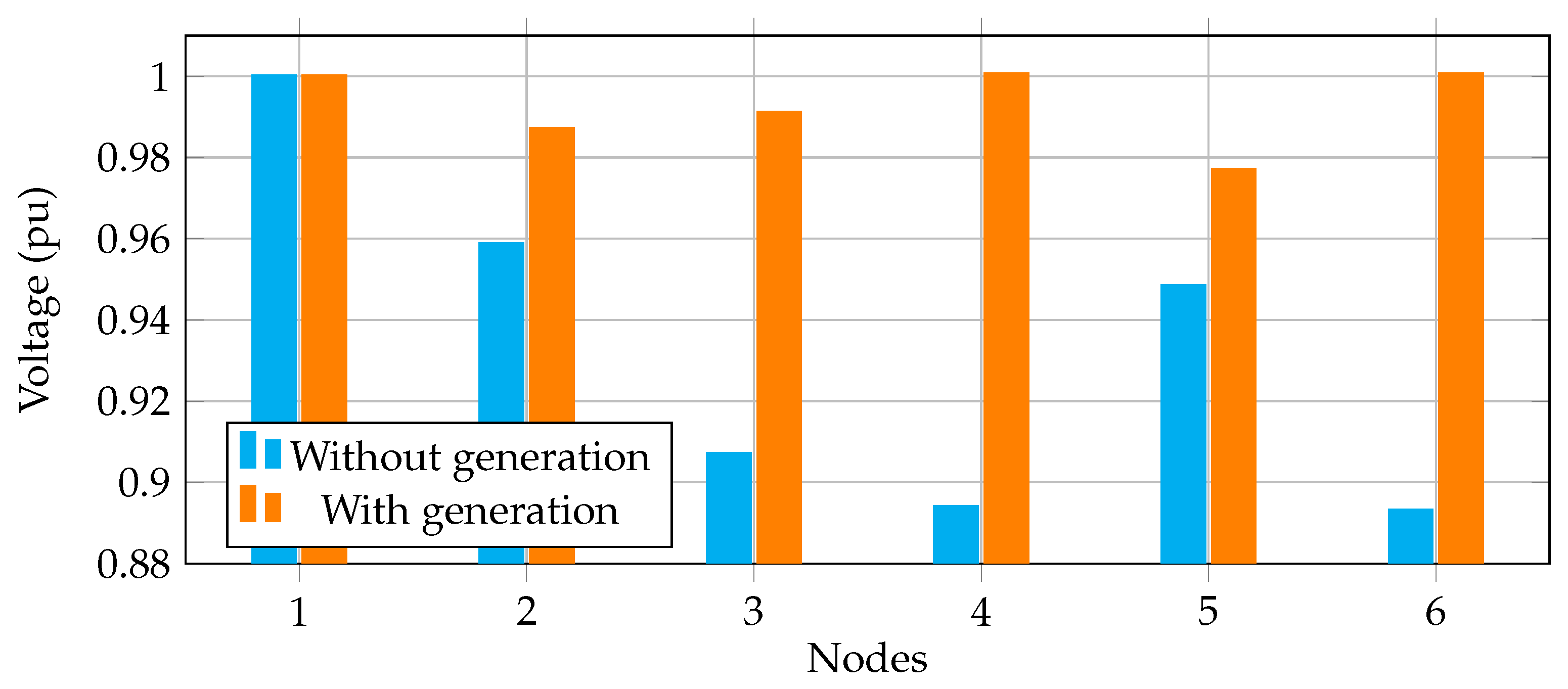Recursive Convex Model for Optimal Power Flow Solution in Monopolar DC Networks
Abstract
1. Introduction
2. Optimal Power Flow Problem
2.1. Objective Function
2.2. Set of Constraints
3. Recursive Convex OPF Approach
- i.
- The fractional relations between power injections in slack and dispersed generation sources involve each one of the two variables, i.e., the power injections and in the numerator, and the voltage magnitude at the denominator. However, we know that the voltage variable in generation sources presents small variations with respect to the ideal value. For this reason, we approximate these as presented in Equations (8) and (9).where represents the voltage value at the iteration t (current linearizing point), which is a predefined value that is being updated recursively as will be described ahead in this document.
- ii.
- The hyperbolic relation between voltages and currents in the fraction term regarding constant power terminals only has a variable the voltage value at the denominator. This implies that different from generators where numerators and denominators are varying, in the demand nodes, only the denominator changes, which means that the value of the variable defines the final value of this relation. For this reason, to approximate this component, we employ the first Taylor’s series expansion of the variable in the linearizing point [27]. This produces the linear equivalent relation in (10).
| Algorithm 1: Recursive OPF solution using a relaxed convex approximation. |
 |
4. Numerical Validations
- i.
- The solution of the classical power flow problem, considering that in the grid there is no penetration of the dispersed generation.
- ii.
- The location of four dispersed generators in the nodes 12, 19, 35, and 63, with nominal capacities of 750 kW each one.
4.1. Comparison with Specialized Power Flow Methods
4.2. Comparison with Combinatorial Optimizers
- i.
- As the literature mentions (see Ref. [15]), the VSA methodology is the most efficient algorithm regarding combinatorial optimization methods to deal with the OPF problem. Note that the difference between the minimum and maximum solutions is less than 1.2263 ×, with a standard deviation of 2.2713 ×.
- ii.
- The BHO and the SCA approaches are stuck in locally optimal solutions with differences of about 1.3586 and with respect to the optimal solution found with the VSA method. These results show that, numerically speaking, the SCA approach can be considered accurate for solving the OPF problem in monopolar DC networks with the main advantage being that its implementation is very simple due to its basic evolution rules [30].
- iii.
- The proposed RCF reaches the global optimal solution of the OPF problem, i.e., kW, considering between four to six decimals. This implies that the difference in the RCF, when compared with the VSA, is few in milliwatts. If we suppose that the global optimum corresponds to the VSA solution, then the RCF has an estimation error of about 6.6279 ×, which implies that for any practical application the RCF method is effective to solve the OPF problem with the main advantage that, owing to the convexity of the solution space, statistical analyses are not required, which is not the case for metaheuristics.
4.3. Comparison with a Semidefinite Programming Model
- i.
- Both convex optimization methods converge to the same global optimal solution with the main advantage that a statistical validation of the effectiveness of these algorithms is not required, because due to the convex nature of the solution space, the optimal solution reached is indeed the global optimum. Note that the difference between the objective functions is lower than some milliwatts, confirming their efficiency to solve the OPF problem in monopolar DC networks.
- ii.
- The numerical results confirm that the SDP and the RCF methods allow solving the OPF problem in radial and meshed monopolar DC distribution networks. In addition, the meshed configuration presents kW of additional energy losses when compared with the meshed configuration. This is an expected behavior in electrical networks with meshes because the voltage profile is improved and the power flows present a better redistribution.
4.4. MATLAB Implementation
5. Conclusions
Author Contributions
Funding
Institutional Review Board Statement
Informed Consent Statement
Data Availability Statement
Acknowledgments
Conflicts of Interest
References
- Simiyu, P.; Xin, A.; Wang, K.; Adwek, G.; Salman, S. Multiterminal Medium Voltage DC Distribution Network Hierarchical Control. Electronics 2020, 9, 506. [Google Scholar] [CrossRef]
- Gelani, H.E.; Dastgeer, F.; Nasir, M.; Khan, S.; Guerrero, J.M. AC vs. DC Distribution Efficiency: Are We on the Right Path? Energies 2021, 14, 4039. [Google Scholar] [CrossRef]
- Xu, F.; Lu, Y.; Huang, X.; Lu, C.; Qiu, P.; Ding, C. Research on DC power flow controllable multi-port DC circuit breaker. Energy Reports 2022, 8, 1163–1171. [Google Scholar] [CrossRef]
- Garces, A. Uniqueness of the power flow solutions in low voltage direct current grids. Electr. Power Syst. Res. 2017, 151, 149–153. [Google Scholar] [CrossRef]
- Gan, L.; Low, S.H. Optimal power flow in direct current networks. In Proceedings of the 52nd IEEE Conference on Decision and Control, Firenze, Italy, 10–13 December 2013. [Google Scholar] [CrossRef]
- Rodriguez, P.; Rouzbehi, K. Multi-terminal DC grids: Challenges and prospects. J. Mod. Power Syst. Clean Energy 2017, 5, 515–523. [Google Scholar] [CrossRef]
- Grisales-Noreña, L.F.; Garzón-Rivera, O.D.; Ocampo-Toro, J.A.; Ramos-Paja, C.A.; Rodriguez-Cabal, M.A. Metaheuristic Optimization Methods for Optimal Power Flow Analysis in DC Distribution Networks. Trans. Energy Syst. Eng. Appl. 2020, 1, 13–31. [Google Scholar] [CrossRef]
- Fan, Y.; Chi, Y.; Li, Y.; Wang, Z.; Liu, H.; Liu, W.; Li, X. Key technologies for medium and low voltage DC distribution system. Glob. Energy Interconnect. 2021, 4, 91–103. [Google Scholar] [CrossRef]
- Li, J.; Liu, F.; Wang, Z.; Low, S.H.; Mei, S. Optimal Power Flow in Stand-Alone DC Microgrids. IEEE Trans. Power Syst. 2018, 33, 5496–5506. [Google Scholar] [CrossRef]
- Garces, A.; Montoya, D.; Torres, R. Optimal power flow in multiterminal HVDC systems considering DC/DC converters. In Proceedings of the 2016 IEEE 25th International Symposium on Industrial Electronics (ISIE), Santa Clara, CA, USA, 8–10 June 2016. [Google Scholar] [CrossRef]
- Montoya, O.D.; Gil-González, W.; Garces, A. Sequential quadratic programming models for solving the OPF problem in DC grids. Electr. Power Syst. Res. 2019, 169, 18–23. [Google Scholar] [CrossRef]
- Turgut, M.S.; Turgut, O.E.; Afan, H.A.; El-Shafie, A. A novel Master–Slave optimization algorithm for generating an optimal release policy in case of reservoir operation. J. Hydrol. 2019, 577, 123959. [Google Scholar] [CrossRef]
- Grisales-Noreña, L.; Montoya, D.G.; Ramos-Paja, C. Optimal Sizing and Location of Distributed Generators Based on PBIL and PSO Techniques. Energies 2018, 11, 1018. [Google Scholar] [CrossRef]
- Muñoz, A.A.R.; Grisales-Noreña, L.F.; Montano, J.; Montoya, O.D.; Giral-Ramírez, D.A. Optimal Power Dispatch of Distributed Generators in Direct Current Networks Using a Master–Slave Methodology That Combines the Salp Swarm Algorithm and the Successive Approximation Method. Electronics 2021, 10, 2837. [Google Scholar] [CrossRef]
- Montoya, O.D.; Gil-Gonzalez, W.; Grisales-Norena, L.F. Vortex Search Algorithm for Optimal Power Flow Analysis in DC Resistive Networks With CPLs. IEEE Trans. Circuits Syst. II Express Briefs 2020, 67, 1439–1443. [Google Scholar] [CrossRef]
- Montoya, O.D.; Giral-Ramírez, D.A.; Grisales-Noreña, L.F. Optimal economic-environmental dispatch in MT-HVDC systems via sine-cosine algorithm. Results Eng. 2022, 13, 100348. [Google Scholar] [CrossRef]
- Chen, Y.; Xiang, J.; Li, Y. SOCP Relaxations of Optimal Power Flow Problem Considering Current Margins in Radial Networks. Energies 2018, 11, 3164. [Google Scholar] [CrossRef]
- Benedito, E.; del Puerto-Flores, D.; Dòria-Cerezo, A.; Scherpen, J.M. Optimal Power Flow for resistive DC Networks: A Port-Hamiltonian approach. IFAC-PapersOnLine 2017, 50, 25–30. [Google Scholar] [CrossRef]
- Li, L. Selected Applications of Convex Optimization; Springer: Berlin/Heidelberg, Germany, 2015. [Google Scholar] [CrossRef]
- Monteiro, A.C.B.; França, R.P.; Arthur, R.; Iano, Y. The fundamentals and potential of heuristics and metaheuristics for multiobjective combinatorial optimization problems and solution methods. In Multi-Objective Combinatorial Optimization Problems and Solution Methods; Elsevier: Amsterdam, The Netherlands, 2022; pp. 9–29. [Google Scholar] [CrossRef]
- Zhang, H.; Vittal, V.; Heydt, G.T.; Quintero, J. A relaxed AC optimal power flow model based on a Taylor series. In Proceedings of the 2013 IEEE Innovative Smart Grid Technologies-Asia (ISGT Asia), Bangalore, India, 10–13 November 2013. [Google Scholar] [CrossRef]
- Liu, J.; Cui, B.; Molzahn, D.K.; Chen, C.; Lu, X.; Qiu, F. Optimal Power Flow for DC Networks with Robust Feasibility and Stability Guarantees. arXiv 2019, arXiv:1902.08163. [Google Scholar] [CrossRef]
- Fantauzzi, M.; Lauria, D.; Mottola, F.; Scalfati, A. Sizing energy storage systems in DC networks: A general methodology based upon power losses minimization. Appl. Energy 2017, 187, 862–872. [Google Scholar] [CrossRef]
- Li, H.; Wang, X.; Lin, J.; Wu, L.; Liu, T. An improved Newton-Raphson based linear power flow method for DC grids with dispatchable DGs and ZIP loads. COMPEL—Int. J. Comput. Math. Electr. Electron. Eng. 2022, 41, 1297–1312. [Google Scholar] [CrossRef]
- Garces, A.; Rodriguez-Garcia, L. An Approach for Nodal Admittance Matrix Real-Time Estimation on DC Microgrids. In Proceedings of the 2019 IEEE Green Technologies Conference(GreenTech), Lafayette, LA, USA, 3–6 April 2019. [Google Scholar] [CrossRef]
- Liu, B.; Wei, W.; Liu, F. Locating all real solutions of power flow equations: A convex optimisation-based method. IET Gener. Transm. Distrib. 2018, 12, 2273–2279. [Google Scholar] [CrossRef]
- Garces, A. A Linear Three-Phase Load Flow for Power Distribution Systems. IEEE Trans. Power Syst. 2016, 31, 827–828. [Google Scholar] [CrossRef]
- Medina-Quesada, Á.; Montoya, O.D.; Hernández, J.C. Derivative-Free Power Flow Solution for Bipolar DC Networks with Multiple Constant Power Terminals. Sensors 2022, 22, 2914. [Google Scholar] [CrossRef]
- Montoya, O.D.; Gil-González, W.; Garces, A. Numerical methods for power flow analysis in DC networks: State of the art, methods and challenges. Int. J. Electr. Power Energy Syst. 2020, 123, 106299. [Google Scholar] [CrossRef]
- Attia, A.F.; Sehiemy, R.A.E.; Hasanien, H.M. Optimal power flow solution in power systems using a novel Sine-Cosine algorithm. Int. J. Electr. Power Energy Syst. 2018, 99, 331–343. [Google Scholar] [CrossRef]



| Methodology | Classification | Year | Reference |
|---|---|---|---|
| Semidefinite programming | Convex optimization | 2016 | [10] |
| Second-order cone programming (SOCP) | Convex optimization | 2018 | [9] |
| Sequential quadratic programming | Convex optimization | 2019 | [11] |
| Black hole optimization | Combinatorial optimization | 2019, 2020 | [7] |
| Continuous genetic algorithm | Combinatorial optimization | 2020 | [7] |
| Particle swarm optimization | Combinatorial optimization | 2020 | [7] |
| Vortex search algorithm | Combinatorial optimization | 2020 | [15] |
| Sine–cosine algorithm | Combinatorial optimization | 2019, 2022 | [16] |
| Method | Power Loss (kW) | Iterations | Error (%) |
|---|---|---|---|
| NR | 58.6974817069044 | 4 | — |
| TBF | 58.6974816840913 | 8 | 3.8865 × |
| SAM | 58.6974817053999 | 8 | 2.5631 × |
| MBFM | 58.6974817051754 | 8 | 2.9456 × |
| HAM | 58.6974817059701 | 4 | 1.5917 × |
| PAM | 58.6974817055268 | 4 | 2.3469 × |
| RCF | 58.6974817665350 | 2 | 1.0159 × |
| Method | Power (kW) | Min. (kW) | Mean (kW) | Max. (kW) | Std. (kW) | Time (s) |
|---|---|---|---|---|---|---|
| BHO | 3.30792201837848 | 3.88938176547841 | 4.85945934769858 | 3.7387 × | 5.6512 | |
| SCA | 3.26423557079929 | 3.44705722809309 | 3.44705722809309 | 3.7791 × | 2.5917 | |
| VSA | 3.26358341808515 | 3.26358341853136 | 3.26358341931154 | 2.2713 × | 2.8837 | |
| RCF | 3.26358363439168 | 3.26358363439168 | 3.26358363439168 | 0 | 1.8438 |
| Method | Power (kW) | Min. (kW) | Time (s) |
|---|---|---|---|
| Radial configuration | |||
| SDP | 3.26360276596915 | 38.5165 | |
| RCF | 3.26358363439168 | 1.8438 | |
| Meshed configuration | |||
| SDP | 2.99597169762933 | 35.1618 | |
| RCF | 2.99596545080895 | 1.8125 | |
| Node j | Node k | () | (W) |
|---|---|---|---|
| 1 | 2 | 0.25 | 1500 |
| 2 | 3 | 0.50 | 1750 |
| 3 | 4 | 0.45 | 1250 |
| 2 | 5 | 0.35 | 1350 |
| 3 | 6 | 0.40 | 1500 |
Publisher’s Note: MDPI stays neutral with regard to jurisdictional claims in published maps and institutional affiliations. |
© 2022 by the authors. Licensee MDPI, Basel, Switzerland. This article is an open access article distributed under the terms and conditions of the Creative Commons Attribution (CC BY) license (https://creativecommons.org/licenses/by/4.0/).
Share and Cite
Montoya, O.D.; Zishan, F.; Giral-Ramírez, D.A. Recursive Convex Model for Optimal Power Flow Solution in Monopolar DC Networks. Mathematics 2022, 10, 3649. https://doi.org/10.3390/math10193649
Montoya OD, Zishan F, Giral-Ramírez DA. Recursive Convex Model for Optimal Power Flow Solution in Monopolar DC Networks. Mathematics. 2022; 10(19):3649. https://doi.org/10.3390/math10193649
Chicago/Turabian StyleMontoya, Oscar Danilo, Farhad Zishan, and Diego Armando Giral-Ramírez. 2022. "Recursive Convex Model for Optimal Power Flow Solution in Monopolar DC Networks" Mathematics 10, no. 19: 3649. https://doi.org/10.3390/math10193649
APA StyleMontoya, O. D., Zishan, F., & Giral-Ramírez, D. A. (2022). Recursive Convex Model for Optimal Power Flow Solution in Monopolar DC Networks. Mathematics, 10(19), 3649. https://doi.org/10.3390/math10193649








